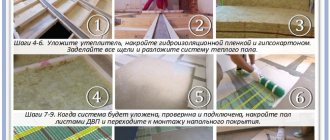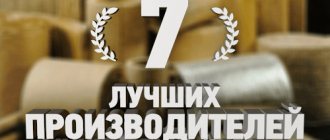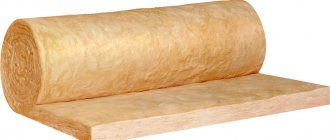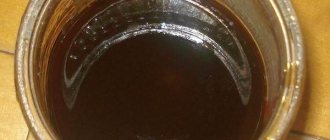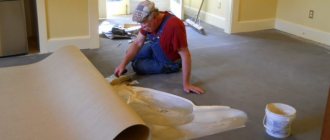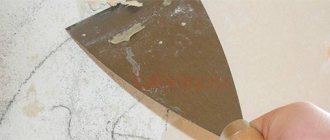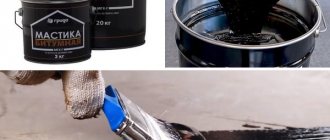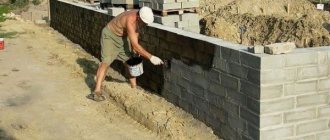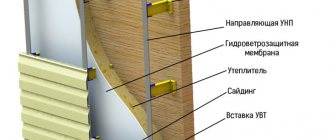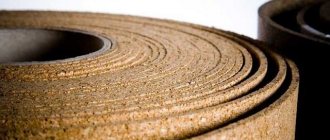Insulation for the home is rightly called “fur coat”. When it’s hot, it allows you to maintain a comfortable microclimate indoors; when it’s cold, it retains valuable heat. And when the time comes to choose such a “fur coat,” you have to prioritize: price or quality? Practicality or safety? Should you trust your neighbor's opinion or advertising? Let's look at insulation that manages to satisfy even the most demanding customers.
Thus, modern stone wool is one of the most environmentally friendly and reliable heat insulators. Its entire secret is in the air, which is in a motionless state between closely intertwined fibers. Which are also made from real stone! How can this even happen?
Now we will reveal all the secrets to you! From this article you will learn: what stone wool is and why it is valuable as insulation, how to use it and what features you should know about. After all, the debate about its practicality and environmental friendliness still does not subside, and the whole point is only in the raw materials used.
What is stone wool and how is it produced?
The method of making basalt wool itself, as they say, is borrowed from nature. When scientists studied a volcanic eruption in the Hawaiian Islands, they noticed the formation of thin threads that gathered into structures like cotton wool. This material was called quite funny - “Pele's hair”, and they tried to repeat the same process in modern construction.
This is how factories today simulate a volcanic eruption in special furnaces: the temperature reaches 1500°C, causing the rock to melt. Then the rocks are simply pulled out into fibers, and they are already connected with binding components into cotton wool of the desired consistency and shape. And most often such binders are synthetic.
After this, the compressed fibers are placed in a polymerization chamber. There, the fibers harden at a temperature of 200°C and form the final product, which is cut into rolls, slabs and mats. Next, they are packaged in a special shrink film:
Thanks to all this, modern stone wool is a heat-insulating material with a chaotic fibrous structure. This direction is given to the fibers by a pendulum spreader, which lays the fibers in several multidirectional layers. After this, the material is fed into the corrugator, and it already presses the wool into a certain carpet, with a clearly measurable density.
As a result, the resulting heat insulator has the following properties:
Basalt wool has always been in demand, even in times of crisis. From year to year, its sales increase by 7-9%. At the same time, competition between manufacturing companies is quite fierce, and many enterprises, in order to keep their product on the market, begin to enlarge (a good example is Isorok).
The leaders so far are TechnoNIKOL, which accounts for about 20%, and Rockwool, with a share of 20%. In total, there are currently about fifty factories in Russia that produce insulation in the form of stone wool.
Content
- Why do you need basalt insulation?
- Composition and properties of basalt insulation
- Types of basalt insulation and scope
- Classification of basalt slabs
- Advantages of mineral wool
- Flaws
- Installation rules
- Basalt insulation Izover Master of warm walls
- Insulation for walls based on quartz Izover warm walls strong
Basalt mineral wool is used at construction and industrial sites for insulation of facade elements, foundations, roofs and floors. The material is characterized by a low thermal conductivity coefficient, making it an effective insulator. For ease of use, stone wool is often produced in the form of slabs, sometimes in rolls and cylinders. Izover is the first and only manufacturer of both stone and quartz wool in Russia. Having full expertise, we will tell you about insulation based on basalt mineral wool.
Unique properties of basalt insulation
Let's look at the main properties of stone wool that make it a unique product.
Fire safety and reliability
As we have already said, stone wool is made today from the gabbro-basalt group, which is absolutely non-flammable. After all, the melting point of such fibers is within 1000°C. It is at this temperature that a stone melts, and finding one even in a strong fire is quite a challenge. This level of heating only occurs at the crater of a volcano. That’s why the most fire-hazardous places are insulated with stone wool.
Not only does stone wool not burn, but it also stops the heat from the fire, thereby protecting the internal building structures of the house. Not only to prevent them from burning, but also to prevent them from becoming deformed, collapsing and falling on people fleeing.
All this often provides additional valuable time for evacuation. If you have heard about fires, when a seemingly strong house flared up like a match and collapsed like a house of cards, it was precisely there that there were no such protective elements in the walls.
As you can see, almost all forms of stone wool belong to the non-combustible group:
Another important point is that even at high temperatures, stone wool does not emit toxic substances. This is also important, because often a fire is dangerous not so much because of the high temperature as because of the toxic air, which usually quickly spreads throughout the premises. And the more things in a residential building that burn easily, melt and stink, the worse it is.
Basalt wool is so fireproof that it is even used for underfloor heating:
Vapor permeability and “breathable” walls
Today, more and more often, owners of their own homes are asking an essential question: how environmentally friendly and safe is our own home? Is the microclimate in it comfortable, will mold be a problem?
And in this regard, two trends in approaching this issue have already developed today. The first is that the house should be like a thermos, and internal air exchange is organized using a supply ventilation system. The second is that the structures of a residential building must be “breathable” so that the house itself “breathes”, but not due to drafts of an unsealed structure, but due to the vapor permeability of the walls (this mainly applies to wooden buildings).
So, stone wool is also completely vapor permeable. Water vapor in the form of molecules easily passes through mineral thermal insulation and does not condense on the fibers. Thanks to this, the stone insulation does not get wet at all. That is why such insulation is ideal for arranging wooden baths, the walls of which, according to all the rules, should “breathe” and not be a dull thermos.
After all, the entire microclimate even in a residential building depends on whether the walls “breathe.” After all, remember that in our country the natural flow of air when the window is closed occurs due to a slight draft from windows and doors, while abroad they often install special supply ventilation for this purpose.
In any case, if it turns out that this is not enough, or the new plastic window turns out to be completely airtight and will block the already scarce micro-air flows, then the dampness will have nowhere to go. As a result, mold and a musty smell will appear in the house.
This is why advocates of environmentally friendly residential buildings talk about “breathable” walls. For this purpose, serious manufacturers issue stone wool with a special certificate, which allows it to be used for insulation of any room in the house, including children's rooms. The microclimate in such premises should be comfortable and safe. And steam can easily escape through the finishing and not linger in the insulation:
Durability and resistance to stress
The shrinkage of stone wool is so insignificant that it does not affect the durability of the thermal insulation at all. Thus, the geometric dimensions of the slabs are maintained throughout their entire service life, and therefore no cold bridges arise.
In addition, mineral slabs have low hygroscopicity - only 0.5% of the volume. Just in case, today stone wool is additionally impregnated with special water-repellent compounds - water repellents. These are oils or organosilicon compounds.
This is necessary in order to keep the wool in the desired condition during its installation. After all, important construction work is often carried out in wet weather, and even when it rains.
And finally, stone wool has high chemical resistance and does not cause corrosion to metal.
Environmental debate
Stone wool is rightfully considered one of the most environmentally friendly, and the products of some manufacturers even have an Eco Material Green certificate.
But let's add a little tar here. There are studies that basalt wool may be unsafe. Back in 1995, the prospectuses of some companies stated that basalt fibers are glued together with synthetic resin, which is obtained by condensation of phenol and formic aldehyde. And the resin differs significantly in its qualities from the fibers themselves. So, in the oven they do not melt to temperatures above 1000 degrees, but resin does not melt at 200 degrees. The dust from cotton wool itself is also dangerous.
The manufacturers themselves claim that the phenol-formaldehyde binder they use in the process of making cotton wool contains very little of it and cannot pose any threat to human health. But back in 1997, the European Union published a classification of insulating materials, where mineral wool was recognized as potentially hazardous depending on its content of alkaline earth metals and alkali oxides.
Unfortunately, today some manufacturers make cotton wool based on a binder such as phenol-formaldehyde. And these are already dangerous volatile compounds, poisonous, belonging to the second class of danger.
Surely you know that formaldehyde is highly toxic, allergenic, mutagenic and carcinogenic. And in stone wool slabs the binder usually contains from 3 to 6%. In addition, there is quite a lot of this substance in the surrounding space, even in the street air, and especially in low-quality furniture, i.e. it accumulates.
Manufacturers actually say that at a temperature of 250°C the binder begins to burn, but the structure of the mineral wool does not oxidize or change. That’s why, if the environmental friendliness of the finishing materials used is important to you, look at the documents for the selected stone wool option: what kind of binder is used there? Resin or starch?
Another important point. Unlike glass wool, basalt wool does not release thousands of small needles into the air, which is the difference between stone wool and glass wool - but you should also work with it carefully! Please note that abroad workers in protective clothing and a mask insulate walls with it, although our home craftsmen like to take glass wool with their hands. After all, basalt fiber produces fine dust, especially when shaking the slabs.
By the way, TechnoNIKOL once conducted a rather interesting study of buyer expectations. And it turned out that for 87% of those surveyed, the main criterion for choosing construction and finishing materials was environmental friendliness.
It was for this purpose that GreenGuard insulation was developed, which today is called something of an eco-breakthrough in modern construction. We'll tell you about it a little later.
Insulation technology, dew point
The first important rule: insulation of facades is always done from the outside (i.e. from the street) and never from the inside (from the room). The exception is rare cases when this is fundamentally impossible (for example, with additional insulation of a city apartment or when the facade of the house is already completed and cannot be remodeled).
This limitation is due to the natural properties of atmospheric air. The higher its temperature, the more water vapor it contains. When the air cools, “extra” moisture condenses, moving from a gaseous to a liquid state, and settles on colder surfaces. A clear illustration of this effect is a fogged glass or bottle of a chilled drink. Cooling sharply near a cold surface, the air releases excess water in the form of steam, which settles in droplets on the glass. The temperature at which fogging begins is called the dew point (this depends on various factors, but this is not important for now).
The glass is thin, but the condensation boundary can be located in the thickness of the structure. For example, inside a wall separating a heated room from a cold street. As the outside temperature decreases, the dew point moves inward, at some point reaching rooms where it becomes damp, uncomfortable, and mold may appear. This often happens in uninsulated dachas or in houses with insufficient thermal insulation thickness (or poor quality of its installation) during a sharp cold snap, as well as in autumn or spring, when the daily temperature difference is noticeable.
If you insulate from the inside, condensation will occur directly in the thermal insulation layer or at the point of contact between the street wall and the insulation, which can become damp and lose its properties, because there is nowhere for it to evaporate excess moisture (there is already excess humidity inside the room).
Therefore, the task of insulation is not only to protect the house from the cold, but also to prevent dampness inside. It is necessary that even at the lowest winter temperatures, the dew point never moves inside the room, or better yet, is always located in the thickness of the external thermal insulation, from where excess moisture will evaporate naturally.
The question of density and quality: is more always better?
Today, many people believe that the higher the density of stone wool, the more practical it is. Actually this is not true. Density has its own clear indicators for use in different conditions.
So, stone wool with a density:
- up to 35 kg/m3 ideal for unloaded surfaces such as roof slopes. It is easily installed between the rafters and holds well between them due to the fact that it is not pulled down by its own weight;
- slabs with a density of 35 to 75 kg/m3 are used for the floor, ceiling and interior walls of the house;
- stone wool with a density of 75 to 125 kg/m3, quite heavy, is used for facade systems.
Each modern stone wool manufacturer has a separate product line for this, with its own clear density:
In general, the thermal conductivity of a material depends on the density of the wool. And density depends on the ordering of the fibers. So, the more vertical fibers you have, the better the thermal insulation itself, and the higher the compressive strength of the slab.
Manufacturers noticed this point and today they are trying to make cotton wool less dense and heavy, but at the same time just as heat-insulating and anti-shrink. In a word, the density of stone wool itself is not linearly related to its strength. So, the less dense the wool with the same strength, the initially the technological process of its production was of high quality.
In addition, there is far more than one spectrum of strength: tensile, compressive, and suited to the task at hand. Thus, roof insulation on flat roofs and screed floors always work in compression. But this same parameter has practically no meaning when it comes to insulating ventilated facades. After all, the strength of the wool to tear off layers is already important here! And there is no compression here.
But if we are talking about layered brickwork, the thermal insulation should be both light and durable, like Rockwool Light Butts Extra slabs. Their density is in the range of 40-50 kg/m3 and tensile strength is 8 kPa.
Thermal calculation
To calculate the thickness of the insulation, appropriate skills or the participation of a specialist are required. However, there are thermal calculators that greatly simplify the task. For example, the basic ISOVER calculator allows you to select the optimal insulation material and calculate its thickness, indicating the region and the main characteristics of the building: building materials, area, height, number of floors, glazing parameters.
For those who are engaged in design or want to receive a detailed calculation of thermal insulation with all formulas and standards, the ISOVER design calculator will help.
For example, in the Moscow region, for an average log cottage, a 50 mm layer of ISOVER Warm Walls Strong mineral wool will be enough. A similar building made of foam blocks will require 100 mm of insulation (its thickness directly depends on the thickness and type of load-bearing walls; before choosing, we recommend making an individual calculation using a heat engineering calculator).
Buy at isover market
Those wishing to study the issue in more detail can familiarize themselves with the contents of the relevant regulatory documents: SP 131.13330.2020 “Building climatology” (new edition, comes into force in June 2022), SP 50.13330.2012 “Thermal protection of buildings”, etc. Insulation of frame buildings in detail describes SP 31-105-2002 “Design and construction of energy-efficient single-family residential buildings with a wooden frame.” This document is an adapted Canadian standard Design and construction of wood-frame single family houses (translated as “Design and construction of wooden frame single-family houses”).
New products on the market: convenient format and high environmental friendliness
Due to the constant competition for their place in the sun, manufacturers are constantly improving the quality of their products or coming up with new products that cannot fail to interest potential buyers.
Let us separately note the popular new product from Rocklight – Rocklight Mini. These are stone wool slabs measuring only 800x600 mm, compared to the more common 1200x600 mm. This format allows you to more accurately calculate the required amount of insulation, avoid mistakes and more conveniently deliver the slabs in your own car.
The eco-friendly insulation GreenGuard, developed using GEOlife technology from TechnoNIKOL, is quickly becoming famous. The peculiarity of the technology is that exclusively natural components are used here: only rocks of the basalt group and biopolymer binders of organic rather than synthetic origin. This type of rock is characterized by high refractoriness, and therefore cotton wool is quite fire-resistant. Therefore, the material is assigned the maximum fire safety class.
Such insulation not only does not burn and does not change shape, but also serves as a certain barrier to fire. And at the same time there will be no poisonous gases or toxic substances, because there are no resins here at all. Modified starch and an organic thickener are used as a binder. The same substances are used today in the food, perfume and diaper industries.
Advantages of mineral wool
Mineral basalt insulation is in great demand in the building materials market due to its advantages, including:
- low thermal conductivity;
- soundproofing (sound absorption);
- non-flammability;
- vapor permeability;
- biostability;
- easy workability.
Stone wool prevents heat loss from the room, and is also an excellent sound insulator (sound absorber) in a comprehensive solution.
This material is not subject to combustion. Basalt fibers allow steam to pass through perfectly. This quality allows for rapid removal of excess moisture from the room.
Basalt-based thermal insulation does not support the development of fungal organisms and is not of interest to rodents, which has been confirmed by tests.
Installation rules
In order to benefit from basalt insulation, it is important to strictly follow the installation technology. Let's consider the procedure for laying insulation under siding, cladding or facing bricks using the example of Izover Master Warm Walls mineral wool:
- Façade preparation – cleaning from dirt;
- Installation of vertical bars for installing insulation or the use of disc dowels (at least 5 pieces per slab, the thickness of the insulation is selected according to calculation); for the greatest energy efficiency, it is permissible to use additional horizontal bars for installing the second layer of insulation;
- Installing Izover Master Warm Walls insulation at the corners with tying the slabs relative to each other as when laying bricks;
- In the case of cladding with siding or block house, a vertical sheathing is installed to form a ventilated gap (if necessary, a windproof membrane is installed over the insulation);
- In the case of brick cladding, a ventilated gap and vents are maintained in the lower and upper parts of the wall;
- When installing siding, follow the manufacturer's instructions.
Video description
Mineral wool or stone wool?
Mineral wool is also produced from metallurgical slag. In particular, it differs from other varieties in its high tensile strength.
This material has gained popularity when used for various purposes. It is suitable not only for thermal protection of the walls or roof of a house, but also for the installation of high-temperature systems and pipelines. A layer of such material can be used to insulate cabins for insulation and noise protection.
Installation of the insulating layer Source remontami.ru
Operating and maximum temperature range
This parameter affects the location of operation, especially if the insulation will be installed on the roof or next to a heat source (boiler, heating radiators). Glass wool has a temperature range of -60 to + 450 °C. Stone wool will withstand even greater temperatures from -180 to + 750 degrees. Here, stone wool is definitely superior to its counterpart.
Water absorption
If there is a possibility that the structure in which the insulation is embedded may come into contact with water, then the water absorption indicator is important, indicating how quickly the insulating layer will get wet. When wet, its properties deteriorate significantly, so when choosing insulation for entrance doors or filling walls in a bathhouse, you should give this priority attention.
The water absorption of glass wool is 1.7% by weight after 24 hours of direct contact with water. Basalt slabs have a value of 0.095%, making it twice as good in this category.
Video description
Basalt wool or mineral wool: comparison of insulation.
Mineral wool is more convenient in this regard. Its fibers are relatively long, soft and durable. This material produces virtually no dust and is more environmentally friendly.
What these materials have in common is that they are both non-flammable. It is believed that these types of insulation are not susceptible to attacks by rodents or pests. If moisture penetrates inside, it will not lead to rotting or fungus formation. The thermal insulation properties of both materials are approximately the same.
Installation of roof insulation Source pulscen.ru
Shrinkability
Shrinkage involves sliding or caking of the insulation after some time. If the tendency of the material to shrink is high, then voids without insulation may form and the thermal insulation of the building will deteriorate.
Here, the difference between basalt wool and mineral fiberglass wool lies in the improved structure of the first. Some of the basalt wool fibers are located vertically, which prevents caking throughout its entire service life. The same cannot be said about glass wool, which, if properly installed, can last for a long period, but will still shrink over time. Glass wool placed in horizontal structures is subject to shrinkage the most, where, in addition to caking, sliding of the material can occur.
Flaws
Despite their manufacturability, basalt insulation materials can generate dust during installation and preparation. To protect the eyes, respiratory system and skin, the worker must use special protective equipment: mask, goggles, gloves and long sleeves.
Another feature of stone wool is the likelihood of getting wet in case of direct contact with water. Basalt does not absorb moisture, but when exposed to rain, it can accumulate it in the voids between the fibers. It will be impossible to dry the insulation after such an incident. Therefore, it is important to store insulating materials in a dry, closed area before starting installation work.
